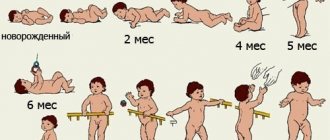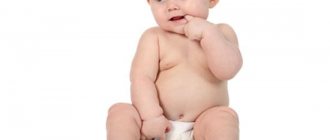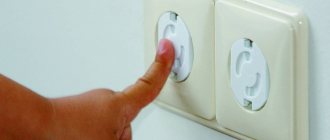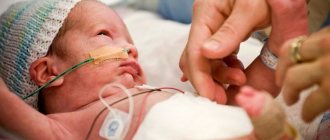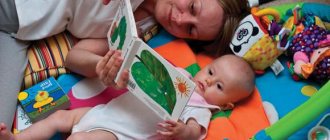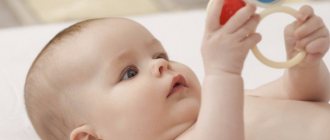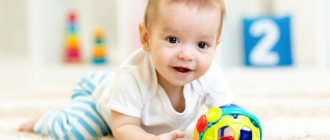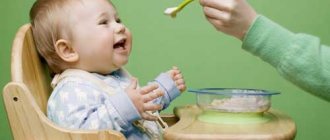Physiological indicators of a child at 11 months - weight and height of the baby at eleven months
The table shows the main physiological parameters of an 11-month-old baby. However, not all children must necessarily fit into this framework, since the development of each child is individual, and hereditary factors also play a role.
| BOYS | GIRLS | |
| Height, cm | 70,0 — 79,0 | 67,5 — 78,0 |
| Weight, kg | 7,6 — 11,7 | 7,0 — 11,2 |
| Head circumference, cm | 43,0 – 48,3 | 41,9 — 47,3 |
At this age, children have 6 or more teeth. The digestive system is fully formed and ready for the transition from puree-like foods to more coarse foods.
Basic skills and abilities
At the age of 11 months, the child absorbs everything like a sponge. If you sit him down at the table with his family, he will begin to develop the correct nutritional culture and food preferences characteristic of a particular family. It is better to start starting the habit of washing your face every morning and evening, brushing your teeth, and also performing other hygiene measures now.
Hand motor skills are improved - this allows you to sort out small objects, string rings onto a pyramid, master sorters and other age-appropriate toys.
What should a child be able to do at 11 months:
- sit down without support. Get up and stand holding onto support;
- walk (holding mother’s hand or stable furnishings). Many children at this age try to take their first independent steps, but if the baby does not do this, do not rush him.
- the child must know his loved ones and be able to distinguish them from other people;
- it is important that the boy or girl show emotions, that is, laugh, rejoice, cry, express interest, etc. The versatility of facial expressions, gestures, and pronounced sounds indicates proper development;
- the baby must respond to his name, that is, turn his head and look at the one who called him;
- the baby is able to show familiar objects in the house at the request of loved ones, as well as have favorite toys;
- it is important that at 11 months the child makes attempts, albeit not very successful, to imitate the adults around him;
- speak at least a few words. It’s great if the baby imitates sounds and accompanies his actions with “voice acting”, for example, rolling a car, saying “brrr”, etc.;
- try to eat with a spoon on your own. Of course, this period is accompanied by endless changes of clothes and a lot of hassle in cleaning the surrounding space, but a little later the baby will learn how to make life easier for both himself and his mother;
- A baby at this age is able to master the first role-playing games. If mom shows how to rock a doll or brush a toy dog, the baby will be able to repeat it.
At 11 months you can try to put your baby on the potty
If the baby is not yet doing something, this does not mean that he is developing incorrectly. However, if there is a significant lag behind the standard schedule, it is better to show the child to a specialist.
At 12 months, it’s time to introduce your baby to the potty. If the child reacts to this by crying and a categorical reluctance to sit on such an accessory, then it is worth postponing the training for at least 1 month.
Sensory development and motor skills of a baby at 11 months
The main task of a baby’s sensory development is to gain knowledge about the shape, color, texture and size of various objects.
A child’s sensory skills in the first year of life play an important role in understanding the world around them and overall development, so special attention is paid to it.
At the age of 11 months, the baby continues to explore surrounding objects, trying them by touch and taste. He enjoys playing with boxes, buckets and other containers of various sizes, putting some objects into others. Children willingly play with bags that have many pockets. By trial and error, they put appropriately sized objects there. At the same time, sensory memory develops - the baby remembers which objects he put in one place or another .
At 11 months, the baby enjoys “reading” books with bright pictures, turning the pages independently. Little ones enjoy pulling laces out of their shoes.
At this age, children can quickly irritate adults by constantly pulling off their socks. You shouldn’t scold an inquisitive little man, it’s just that in this way he learns new movements and actions.
The study of the properties, sizes and shapes of objects occurs with active movement of the hands and the development of fine motor skills. The baby squeezes rubber toys, rolls a ball, takes small toys with two fingers, mastering the tweezer grip, puts small objects into large ones, successfully uses a spoon and drinks from a cup independently.
At 11 months, other motor skills also improve:
- While standing in a playpen or crib, the baby rises on his toes .
- Sits independently from a standing position.
- Able to squat , squat and bend independently.
- Many children begin to take their first independent steps , maintaining balance by balancing their arms.
Physical development
To correctly assess a child’s development, it is important to pay attention to the parameters of his physical health.
Nothing should be overlooked by relatives and doctors. A practically independent person who already knows and can do a lot is an 11-month-old child. Height, weight, and other parameters of the baby are of primary importance in assessing his health and development at this stage. Parents carefully monitor the baby and are guided by these indicators. A child's height at 11 months is on average 72–75 cm; for boys this figure is slightly higher. A baby at this age weighs about 9–11 kg, and the weight depends entirely on the method of feeding and physical activity. Those children who spend a lot of time in the arms of their parents and play a lot of quiet games weigh more than their restless peers. On average, a child gains 400 g every month, and height during this period increases by 1–1.5 cm. But these indicators are purely individual: they depend on genetics, nutrition, physical activity, and concomitant diseases of the baby.
At 11 months, the child’s weight “evens out”: previously accumulated surpluses are actively spent at the time when the baby crawls or begins to take his first steps. He can crawl masterfully, sit down from any position, step with his feet on a support, and often even walk on his own.
Speech development of a child aged 11 months
At 11 months, the child successfully replenishes both his passive and active vocabulary.
At this age, the baby actively imitates the sounds he hears, so when communicating with the baby, you should not lisp or distort words. The baby should hear correct, smooth and intelligible speech.
| Replenishing passive vocabulary | For the overall harmonious development of the baby, including his speech, you need to spend as much time as possible with the child. While the baby cannot speak, he, listening to the speech of loved ones addressed to him, replenishes his passive vocabulary. To expand the set of words familiar to the baby, you need to constantly introduce him to new objects, phenomena or actions. To do this, talk more with your baby, commenting on both your and his actions, read him new fairy tales, introduce him to new characters. |
| Communication with dad | At 11 months, the child already understands well the intonations of the person talking to him. In men, speech sounds are modeled at lower frequencies and have a special sound timbre. Dad's speech has more businesslike and motivating notes than mom's emotional conversation. The timbre of voice and intonation with which dad communicates with the baby are just as important for the development of the baby’s speech and intelligence, as is communication with mom. |
| Speech imitation | Parents should encourage their baby to babble and encourage him to make new sounds. This will help quickly replenish your baby’s active vocabulary. First, the baby learns to pronounce words consisting of identical syllables. Of course, the baby’s first words are “mom” and “dad”. But at 11 months the baby masters other sounds and words, for example, doll “la-la”, chicken “co-co”, dog “av-aw”. The more you communicate with your child, the faster and better he will speak in the future. |
Sensory abilities and motor coordination
The motor skills of children's fingers are so developed that the baby can easily perform even “difficult” tasks. What should a child of 11 months be able to do, how can he play, and how can he diversify his leisure time? Classic toys come to the aid of parents: a ball, a pyramid, a tumbler, as well as pushers, various sorters, cubes and music books.
A child at 11 months can already put small toys or objects into a container and tries to play with the sorter, selecting the necessary parts. He enjoys assembling and disassembling a pyramid, building “castles” from cubes, playing with a tumbler and pressing buttons, expecting a familiar melody as a reward. The eleven-month-old child's skills have not yet been perfected, but every day the movements become more confident and accurate.
Baby's first independent steps at 11 months
By 11 months, the baby’s muscles are already sufficiently developed, so most babies attempt to walk without assistance at this age. If the baby begins to move around the crib or in the playpen, standing on his legs, at 8-9 months, then it is quite difficult for him to take the first steps on the floor on his own. This is due to the fact that children do not have an innate sense of balance and coordination of movement is not sufficiently developed .
To stay upright without support, the baby repeats the same movements many times, trying to find a balance point. At the same time, the development of the vestibular apparatus and coordination of movements occurs. The baby learns the laws of gravity in practice, repeatedly rising, taking a couple of timid steps, and plopping down on a soft place.
When your baby is learning to walk, you need to be next to him to help him in case he falls forward or onto his back. Since the baby does not know how to place his hands when falling, he can break his nose or the back of his head.
Emotions and social development
The child understands the value of human communication and does not want to be left alone in the room. He is more interested in playing with adults than alone. It’s time for parents to start learning the basics of painting and music with him, since at 11 months the baby perceives primary colors, simple shapes, distinguishes the tones of melodies and is able to imitate simple “dance” movements. It is useful to listen to children's or folk songs, classical music. The development of a child at 11 months is such that it allows you to begin attending specialized classes for the little ones.
At this age, the baby begins to actively show his character. He clearly and violently expresses joy, dissatisfaction, fear, and resentment. Attentive parents who listen to their child understand his emotional state and mood. A child at 11 months can identify a favorite food, toy or activity.
An important condition for the socialization of a little person is communication with peers. An 11-month-old infant reacts positively to other children, tries to play with them, learns simple skills and productive interaction.
Games with an 11 month old baby to develop balance
To make your baby feel more confident, you can use a few simple exercises to develop balance:
| We move along the “log” | An ordinary ironing board located at floor level is used as a log. The baby is seated or placed on his legs on one end, and a toy is placed on the other. The child’s task is to get to the second edge along the board. |
| We'll call, we'll knock | Any sounding object (tambourine, bell or drum) must be hung at a height accessible to the child. Lead the baby by the hand to the toy and show how to knock on the object or ring the bell. When insuring the child, stand behind him and let go of his hand. Having been carried away by the toy, the baby will be able to stand without support for several seconds or take the first independent step . |
| Encouragement to walk | Take your child by the hand and push a bouncy ball in front of him, encouraging him to follow him. As soon as the baby reaches the goal, roll the ball to the other side. You can encourage your baby to use his favorite toy. In this case, two adults participate in the game. One insures the child, and the other, showing a toy, calls the baby to him. The desire to definitely take possession of the toy dulls the baby's fear and encourages him to take his first steps . If your baby falls on his butt after taking a step, pick him up and give him a chance to play with his favorite pastime as a reward. |
| Let's swing! | Riding the baby on a rocking horse develops the vestibular apparatus well and promotes the development of balance. In addition, riding your baby on a large toy car or other toy will help you gain a sense of balance. Children really like this activity, and in order to hold on and not fall, they mobilize all their strength. |
Development activities
For the development of a child at 11 months, it is necessary to carry out the following activities:
- Encourage your baby to crawl and walk. Offer to step over the ribbon lying on the floor, while holding his hand. Let the little one also follow the ball, the stroller, and move around with the wheelchair toy.
- Teach your child to go down the stairs, he should be able to do this. It is usually much easier to go up stairs than to go down them.
- Develop fine motor skills and spend a lot of time doing gymnastics for little fingers. Give him a spoon and let him pour the cereal from one container to another. Draw with him on a tray of flour. Offer to assemble a pyramid, and also put rings of different sizes on your fingers and yours.
- While swimming, the baby can catch small floating toys with a sieve or ladle.
- Wrap the toy in paper or foil and give it to your baby to unwrap it. Offer to open the box and jar with a screw cap.
- Play story games with your baby. For example, you can feed the bear, put a hat or vest on the doll. At the same time, you can show your baby different life situations, for example, a bear asked a bunny for a cube and he shared it with him, the doll fell and cried because it hurt.
- Do some modeling and drawing. Give your baby salt dough, safe plasticine that creases well, as well as thin pencils, felt-tip pens or crayons.
- Develop speech through constant communication with your baby. When showing or giving toys, name them. Doman cards can serve as a visual aid. Comment on your actions.
- Read books every day with your baby. Ideally, there should be a bookshelf accessible to the baby so that he can reach it and choose a book whenever he wants. Read aloud to your child and tell stories using pictures.
- If you go shopping with your toddler, show him different products, encourage him if he wants to put several items in the basket himself.
- The baby needs to communicate with other children. To do this, go out to the area for a walk, make new acquaintances, invite families with children to visit you.
Social-emotional development of the baby at eleven months
By 11 months, children are learning new social skills. The baby gradually ceases to be afraid of unfamiliar people and makes contact more actively. The child watches with curiosity those he likes and carefully copies their facial expressions and gestures.
The baby tries to provoke adults to take certain actions and observes their reaction to his behavior. He treats each family member differently, and in order to achieve something from adults, he chooses different models of behavior.
By 11 months, the baby becomes more developed emotionally. Now he expresses his feelings not only by crying or smiling, but by a whole range of different feelings. The baby develops his own preferences for certain people, toys, and products. The baby already knows how to be jealous or angry, and show love to loved ones. The baby becomes purposeful and tries in any way to achieve the intended goal . The baby loves to be praised. He communicates his feelings and experiences through facial expressions, gestures, various emotions and intonation.
Development of the speech apparatus
By the 11th month, the development of the speech apparatus is almost complete, the baby can already pronounce syllables, some can already speak individual words, but there are exceptions. If previously the child uttered sounds unconsciously, now he can definitely clearly name individual objects (sounds, syllables or even words) and greet acquaintances with the corresponding names or sounds - mom (ma), dad (pa), food (yum).
At this time, it is worth actively introducing the child to new words and phenomena, using for learning not only pictures and books, but also interactive toys that reproduce sounds or words, the main thing is to ensure that the words are pronounced correctly.
It is worth talking to a child in normal human language, a car, not a bibika, an apple, not a yum-yum. The child must hear clear, correct speech, new words in correct and complete pronunciation. It is worth telling him about what you are doing and what he sees. Teach him to correlate words and images in children's books.
Useful: Teaching your baby to roll over on his own
Baby's diet at 11 months
You need to feed your baby healthy, balanced food rich in vitamins and minerals.
In general, a child’s diet is not much different from the menu of a 10-month-old baby. To develop the jaw apparatus and give work to the teeth, you need to reduce the amount of pureed food . Foods such as stewed vegetables and fresh fruits should be given to the child in the form of pieces. The baby must learn to bite and chew food.
I can do everything, I can do everything!
This is not all that a child of 11 months should be able to do. Or rather, he doesn’t owe anyone anything: each baby develops according to an individual program laid down at the genetic level, which is easily corrected by parents and pediatricians. It is important for moms and dads to remember that a child is an individual with his own needs and capabilities, so it is unacceptable to compare your baby with another. Love, multiplied by patience and work, is the key to a happy childhood and a healthy baby!
And be sick - skillfully
Although the baby has become stronger, he is now very vulnerable to viruses that cause ARVI. These diseases, which we call colds in everyday life, always become more frequent in the fall, in damp, cold weather. There are a lot of people sneezing and coughing around, and if you are close, it is easy to become infected. Try not to travel with your child on public transport or go into stores. If anyone in the family gets sick, let them not have contact with the baby. But, of course, when ARVI is, as they say, on the doorstep, it’s difficult to protect yourself.
Children usually fall ill acutely, right away, and yet the mother’s heart senses, the mother’s eye catches some weak harbingers: either the baby slept a little more restlessly, or did not eat so willingly, or did not play so joyfully. Several hours passed, and now he was becoming capricious, refused another meal, and his temperature rose. Now there is no doubt - I got sick. And the time is in the evening, the doctor will come only tomorrow... What to do now?
So that you do not repeat those typical mistakes that many mothers usually make in this situation, let us first agree:
what not to do:
- There is no need to wrap the child up. Children overheat very easily, and if at a temperature of, say, 38° you cover him with a cotton blanket, the temperature can rise to 39° or even higher.
- If the temperature does not exceed 38-38.5°, do not give antipyretics. It is necessary to rush into this only if the child has ever had seizures and the neurologist warned that they could recur. For other children, this temperature is harmless; moreover, it is a protective reaction that promotes better production of interferon in the body, which resists viruses.
- Do not give your child antibiotics or Bactrim or Biseptol. These are antibacterial drugs, they do not act on viruses and will not bring any benefit now, but will add harm, since they often cause allergic reactions and almost always contribute to the development or intensification of dysbacteriosis: while destroying harmful flora, they at the same time destroy useful ones.
- Of course, if a child, more than expected, develops any complication of a bacterial nature - otitis media, bronchitis, pneumonia, antibiotics and sulfonamides cannot be avoided. But then, when prescribing them, the doctor will simultaneously select remedies that can, if not prevent, then at least mitigate side effects.
But what can you still do? How to help the baby? If your home medicine cabinet contains (and during the ARVI season this is desirable) homeopathic medicines such as German influenza-hel or our domestic (by the way, cheaper) anti-grippin, start giving it! The advantages of such products are that they increase the body's defenses and almost never cause allergic reactions. Give flu-heel half a tablet dissolved in boiled water every hour and, as your condition improves, increase the interval to four hours. The course of treatment is a week. If the disease began very acutely, with a sharp rise in temperature, during the first hour, give flu-heel in the same dose every 15 minutes. Antigrippin is used in the same way, dissolving one grain at a time in water.
But let’s say there are no homeopathic remedies in the house, and the child’s temperature approaches 39°. Then it is permissible to give an antipyretic, preferably paracetamol or efferalgan, which also contains paracetamol.
What if there is no paracetamol or it has little effect? Resort to a simple and quite effective remedy: open the child completely, unbutton or take off his pajama blouse, shirt, wipe his hands with a napkin soaked in cool water (18-20°). Feel the legs - and at high temperatures they may be cold. If so, rub them until they are red, this will also increase heat transfer.
The doctor will prescribe further treatment. And your responsibility, under all conditions, will remain what pediatricians call “mother therapy,” that is, care!
The most annoying thing for a baby is a runny nose. Try cleaning the spout using the smallest baby enema bottle, not a used one, but a new one. You need to press one nostril, carefully insert the tip of the balloon into the other and suck out the mucus. You can dry the nasal mucosa with vasoconstrictor drops - they come in different versions, but you need special ones for children. If you don’t find these and you have ordinary sanorin or galazolin on hand, be sure to dilute them with boiled water in a ratio of 1: 3. You can use the drops for no more than three days! Then they begin to have the opposite effect. And do not forget that it makes sense to bury them only after suctioning out the mucus.
The child, of course, does not like both of these procedures and he resists as best he can. There is an easier way: if you put the baby on his stomach, the mucus will begin to flow out on its own, and all you have to do is wipe it with a soft handkerchief.
The baby does not know how to clear his throat on his own. Help him by tapping his chest with your fingertips. Drink warm tea, fruit juice, compote more often: plenty of warm drink is also a medicine.
ARVI progresses in different ways - both relatively easy, ending in 5-7 days, and more severe, longer, with complications. How will things go for you? Some things can be foreseen. If, for example, one of the parents or older children had ARVI often complicated by otitis media, it is more likely to expect the same. First aid in this case is a warm compress, the rest will be prescribed by the otolaryngologist. If someone from the older generation suffers from allergic diseases, the child is more likely to develop croup.
Children with an allergic mood in the body, suffering from diathesis, overweight, and loose children are more prone to this formidable complication. If your baby is like this, from the first day of illness, give him prophylactically tavegil, diazolin or another antihistamine, in the dosage prescribed for exacerbations of diathesis.
This is especially necessary for boys; they develop croup more often than girls.
The danger of croup - swelling of the mucous membrane of the larynx - is in its sudden, sharp onset and the possibility of rapid transition from the relatively mild first stage to the severe second and life-threatening third.
This usually happens in the evening or at night. When you hear an unusually rough, hoarse, barking cough, you will immediately understand what is going on. The order of your actions: mom takes the child in her arms, tries to calm him down, dad urgently opens the hot shower in the bathroom, all the hot water taps. Stay there with your child: breathing in moist, warm air may help. If after a few minutes he does not feel better, his breathing remains noisy, hoarse, he cannot hesitate or hesitate - call an ambulance!
A child’s illness is a test for parents. It is very difficult not to worry, not to be nervous. But call upon all possible calm! After all, your nervousness is transmitted to the child and harms him. Be patient, even, affectionate - then he will be more patient and calmer. What can you do, illnesses are inevitable, and you also need to be able to get sick...



